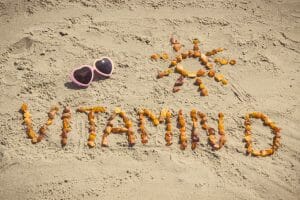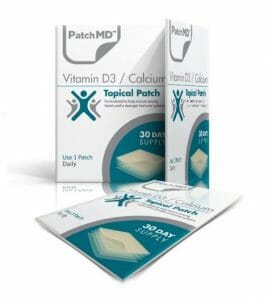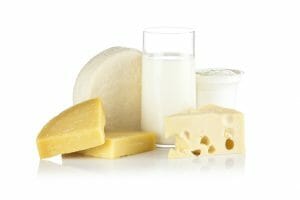Best Calcium Supplement for Kids

Calcium is a vital nutrient required by people of all ages that aids with bone development, as well as properly functioning nerves and muscles. Everyone should ensure that they meet their daily recommended values for calcium in order to maintain strong bones and reduce their risk of bone loss as they age.
Although it is important for everyone to get enough calcium each day, it is perhaps most crucial for children to meet their minimum daily needs in order to prevent stunted growth, weak muscles, or other various health issues as they age.
By building a solid foundation for calcium intake at a young age, children can ensure that they develop and maintain a healthy body throughout their entire lives. In order to ensure that their children are receiving the proper amount of calcium for growth and development, parents should supplement their children’s daily intake with the PatchMD Vitamin D3/Calcium Patch.
Let’s take a closer look at the role of calcium in the development of children and why the PatchMD Vitamin D3/Calcium Patch is the Best Calcium Supplement for Kids.
Table of Contents
Calcium Requirements in Children
Calcium is known for being the most abundant mineral in the body and is responsible for a plethora of functions. Calcium plays its largest role in supporting bone structure and function, but it also aids other processes such as cell signalling, hormonal secretion, and the function of muscles and nerves. Generally, children consume calcium through food sources such as dairy products and select vegetables, however in some cases they may need to use supplements to meet their daily needs.
The recommended dietary allowances for calcium in children are dependent on age and range from as low as 200 mg per day for children 0 -6 months up to 1,300 mg a day for kids ages 9 – 18. Children who fail to meet their minimum daily requirements for calcium intake may not face immediate or short-term health effects but will be placed at a much higher risk for bone damage as well as conditions such as osteopenia, osteoporosis, and rickets.
In the United States it has been reported that less than 20% of children ages 9 to 13 consume the recommended daily amount for calcium and that less than 60% of teen boys and only 10% of teen girls meet their daily calcium requirements. Over 90% of the maximum bone mass acquired by humans is reached by 18 years of age which makes intervention during childhood essential in ensuring that individuals develop properly in terms of long-term health.
Groups at Highest Risk for Low Calcium
Among children there are certain groups which are at higher risk than others in respect to calcium deficiencies.
Groups of children which generally have lower overall calcium intake than others include:
- Girls who compete in sports.
- Girls who are prone to amenorrhea.
- Children with allergies to or have an intolerance of lactose or cow’s milk.
- Children who consume vegetarian or vegan based diets.
Young girls who experience amenorrhea, from either genetic reasons or as a result of athletics, have decreased calcium absorption along with a higher urinary calcium excretion rates which often leads to decreased bone formation or bone mass.
Children with lactose intolerance, or those who have allergies to dairy products, are unable to consume most food products which typically provide children with ample amounts of calcium.
In addition, children who consume a primarily plant-based diet also consume less food products which generally contain a high amount of calcium, and they have lower rates of calcium absorption due to their high intake of oxalic and phytic acids from vegetables which interfere with calcium absorption.
Those who do not consume dairy products may supplement calcium with other foods in their diet such as vegetables like kale, bok choi, Chinese cabbage, broccoli, and collards. In most cases, children from each of these affected groups will not meet their calcium requirements from food alone and should take daily calcium supplements to ensure they meet their daily needs.
Vitamin D Along with Calcium

Soaking up the summer sunshine is one of the best (and most enjoyable) methods for boosting Vitamin D levels.
Although calcium is critical for bone development and other metabolic processes, it should be mentioned that the consumption of vitamin D along with calcium enhances bone development even further.
Vitamin D is responsible in aiding the body with calcium absorption and provides a collaborative effort along with calcium in the support of bone development. Children may absorb vitamin D primarily through exposure to the sun, however most kids do not spend enough time outside anymore to meet their daily needs from sunlight alone.
Children may consume dairy products or vitamin D supplements to ensure that they’re consuming not only enough calcium each day, but also enough vitamin D. It is generally recommended for people of all ages, and children that are at least 4 years old, to consume 600 International Units (IUs) of vitamin D each day.
PatchMD Vitamin D3/Calcium Patch – The Best Calcium Supplement for Kids

When deciding upon a calcium supplement it’s important to keep in mind several factors such as the route of administration, overall calcium content along with the quantity of other minerals and vitamins, as well as the purity of the product and the materials used to make or administer it. Thankfully, the PatchMD Vitamin D3/Calcium Patch meets the highest standards for administration, overall quality of content, and purity when compared to other calcium supplements.
In respect to nutrient delivery, the PatchMD Vitamin D3/Calcium Patch is administered via the transdermal route and provides sustained release for maximum calcium absorption. Most other calcium supplements are taken through the oral route and are less effective in respect to absorption rates and bioavailability.
Along with its enhanced bioavailability properties, the patch can also be placed on several areas of the body, such as the shoulder, back, or hip, and its effects last up to 8 hours. Since this product is provided in a patch form, parents don’t have to worry about their kids not wanting to use the product due to unfavorable taste, as is the case with other products which may be bitter or bland.
The PatchMD Vitamin D3/Calcium Patch also provides 1000 mg of calcium per patch which would meet the daily calcium requirements of most children through the use of a single patch alone. Along with providing an ample amount of calcium, the patch also provides a generous amount of:
- Vitamin D3 (2000 IU)
- Magnesium (250 mg)
- Vitamin K2 (200 mcg)
Finally, the PatchMD Vitamin D3/Calcium Patch is made from all-natural and hypoallergenic materials. This relieves parents from the stress of exposing their children to products which may contain hidden artificial ingredients and materials which may lead to skin sensitization.
In many cases, children experience allergic reactions from certain calcium supplements due to their coating materials. These coatings often contain milk, soy, or wheat proteins which lead to a realm of allergic reactions and intolerance. There is also the risk of exposure to certain dyes including but not limited to Blue No. 1, Blue No. 2, Green No. 3, Red No. 3, Red No. 40, Yellow No. 5 and Yellow No. 6. (388)
Foods to Consume with the PatchMD Vitamin D3/Calcium Patch
The PatchMD Vitamin D3/Calcium Patch contains enough calcium and vitamin D3 for children to meet their daily requirements for each nutrient.
However, it is always recommended that children consume both nutrients from their diet, primarily to set better dietary habits, but to also ensure that they receive their minimum required intake in case they forget to wear the patch on some days, or can’t wear the patch during certain activities, such as swimming.
In addition to dairy products, the following foods greatly aid children in their consumption of calcium and vitamin D and should be consumed as often as possible depending on a child’s dietary needs or preferences:
• Kale (250 milligrams per 100 g )
• Tofu (680 mg per 100 g)
• Kidney bean packs (140 mg per 100g of raw beans)
• Soybeans (280 mg per 100 g)
• chickpeas and white beans (120 mg – 160 mg per 100 g of raw beans)
• almonds (260 mg per 100 g)
• sesame seeds (980 mg per 100 g)
Meeting Children’s Dietary Needs for Calcium
Parents should always ensure that their children consume enough calcium each day to meet their daily requirements. This will allow children to grow and develop properly, as well as greatly decrease their risk of bone-related health conditions as they age.
Although children should aim to consume enough calcium from their diet alone, it has been shown time and time again that the majority of children continue to fail meeting their minimum needs without the use of supplementation alongside a proper diet.
By using the PatchMD Vitamin D3/Calcium Patch, children will be more easily able to not only meet their daily requirements of calcium, but that of vitamin D as well.
References
Alkilani, A. Z., McCrudden, M. T., & Donnelly, R. F. (2015). Transdermal Drug Delivery: Innovative Pharmaceutical Developments Based on Disruption of the Barrier Properties of the stratum corneum. Pharmaceutics, 7(4), 438–470. doi:10.3390/pharmaceutics7040438
Alsaqr, A., Rasoully, M., & Musteata, F. M. (2015). Investigating transdermal delivery of vitamin D3. AAPS PharmSciTech, 16(4), 963–972. doi:10.1208/s12249-015-0291-3
Bailey DA, McKay HA, Mirwald RL, Crocker PR, Faulkner RA. A six-year longitudinal study of the relationship of physical activity to bone mineral accrual in growing children: the university of Saskatchewan bone mineral accrual study. J Bone Miner Res 1999;14: 1672–9
Calcium Fact Sheet for Health Professionals. (2019, July 9). Retrieved from https://ods.od.nih.gov/factsheets/Calcium-HealthProfessional/
French SA, Fulkerson JA, Story M. Increasing weight-bearing physical activity and calcium intake for bone mass growth in children and adolescents: a review of intervention trials. Prev Med 2000;31: 722–31.
Furuta, L. (n.d.). Calcium and Vitamin D Deficiency: What You Need to Know. Retrieved from https://www.childrenscolorado.org/conditions-and-advice/sports-articles/sports-nutrition/calcium-and-vitamin-d-deficiency-what-you-need-to-know/
Institute of Medicine. (2010, November). Dietary reference intakes for calcium and vitamin D. Report brief. Retrieved from https://www.nap.edu/catalog/13050/dietary-reference-intakes-for-calcium-and-vitamin-d External Web Site Policy
Kruse, R. W. (Ed.). (2017, August). Calcium (for Parents). Retrieved from https://kidshealth.org/en/parents/calcium.html
Lanou AJ, Berkow SE, Barnard ND. Calcium, dairy products, and bone health in children and young adults: a reevaluation of the evidence. Pediatrics 2005;115: 736–43.



